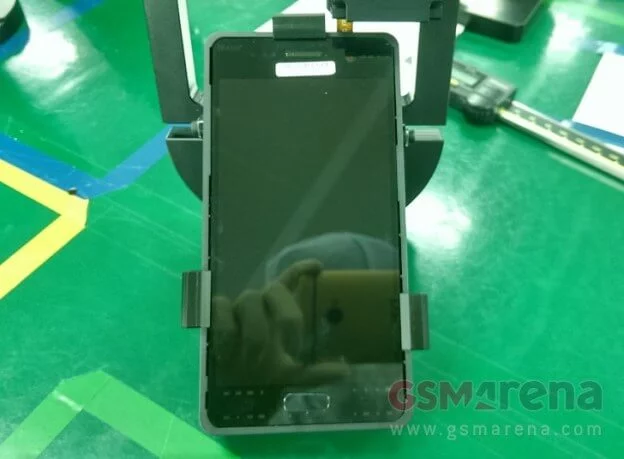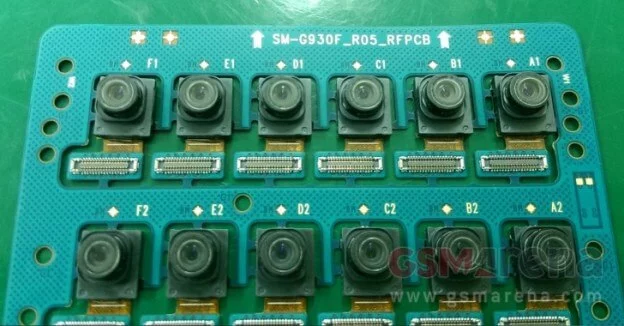Samsung is all set to unveil its upcoming flagship family of smartphones, the Galaxy S7 and the Galaxy S7 edge, during its press conference at MWC (Mobile World Congress) 2016. The company hasn't revealed anything about the upcoming devices, but there have been multiple leaks that suggest the design and possible specifications of the smartphones.

First of all, here's a leaked image of the device that GSMArena got hold of yesterday. According to various other leaks and reports, the design of the Galaxy S7 is set to be quite similar to the Galaxy S6, and this leaked image falls in line with those reports. More importantly, the camera module is expected to be flush with the body. The device's exterior shell will sport the same glass-and-metal build that we've seen in the high-end smartphones from the company released in 2015.
The screen size of the device is expected to remain at 5.1 inches, but there have been some leaks hinting towards a 5.5-inch display on the Galaxy S7 edge+. Unlike the Sony Xperia Z5 Premium, Samsung will not move to a 4K display, at least not this year. So, the screen resolution will remain at 1,440 x 2,560 pixels, and the display will be protected using Gorilla Glass 4.
Samsung Galaxy S7 and Galaxy S7 Edge specifications
- Android 6.0.1 Marshmallow operating system with TouchWiz UX
- 5.1-inch/5.5-inch Super AMOLED display, 1,440 x 2,560 pixels, Corning Gorilla Glass 4
- 12.1-megapixel rear-facing camera with dual-pixel autofocus system, OIS, /1.7 aperture, LED flash, Auto Live HDR, and 4K video recording
- 5-megapixel front-facing camera, ƒ/1.7 aperture, Auto Live HDR, QHD video recording
- Samsung Exynos 8890 processor/Qualcomm Snapdragon 820 processor and 4GB RAM
- 32/64GB internal storage space with microSD card slot (upto 128GB)
- IP67 water-resistant and dust-resistant
- Accelerometer, ambient-light sensor, fingerprint sensor, gyro-sensor, heart-rate monitor, and proximity sensor
- 4G LTE (Cat.12/13), 3G HSPA+, and 2G EDGE
- 2.4GHz and 5GHz Wi-Fi ac/a/b/g/n, Wi-Fi Direct, Miracast, DLNA, Wi-Fi Hotspot, Bluetooth v4.1, IR Blaster, and GPS (with A-GPS and GLONASS)
- NFC, USB Type-C port, and 3.5mm headphone jack
- 2,850 or 3,000 mAh non-removable battery
Moving onto the camera, Samsung has decided to move from a 16-megapixel camera to a 12.1-megapixel one, but the camera sensor itself will be larger, allowing improved image quality. Moreover, OIS and ƒ/1.7 aperture would result in brighter and sharper images in low-light conditions. The front-facing camera's resolution will stay at 5 megapixels, but a wider aperture will improve the overall image quality. The primary camera will be capable of recording 4K videos, while the secondary camera would be able to record QHD videos.

In terms of processing, Samsung will use its homegrown Exynos 8890 processor in the Galaxy S7 and the Galaxy S7 edge. This new processor features a custom-developed CPU, which has been designed by Samsung in house for faster performance than usual Cortex-A57 cores from ARM. According to some leaks from Geekbench, the Exynos 8890 seems as fast as Apple's A9 chipset. Its performance will be as good as Qualcomm Snapdragon 820 SoC.
Samsung will also use Snapdragon 820 chipset in some variants of the Galaxy S7 and the Galaxy S7 edge. These variants might be released in China and the US. Exynos variants will most probably released in Korea, India, Europe, and some other markets around the world. These devices will also feature 4GB RAM, 32/64GB of internal storage. More importantly, Samsung is expected to bring back the microSD card slot, attracting long-time Samsung fans.
Now coming to the most surprising feature, Samsung is looking to bring back IP67 water and dust-resistance to the Galaxy S lineup with the Galaxy S7 family of devices. Considering that Sony offers water resistance without covering the headphone jack and the microUSB port, it's not hard for Samsung to offer this with the Galaxy S7. Other features include a heart-rate monitor and a fingerprint sensor (integrating into its home button).
Connectivity wise, the Galaxy S7 is expected to feature 4G LTE (Cat. 12/13) and dual-band gigabit Wi-Fi. Other regular connectivity features include Wi-Fi Direct, DLNA, Miracast screen mirroring, Android Beam, Bluetooth v4.1 with LE, GPS, and NFC. As per SamMobile, Samsung is also expected to introduce USB Type-C port with the Galaxy S7 and S7 edge. In terms of battery, the South Korean smartphone giant is expected to equip its flagship smartphone for the first half of 2016 with bigger battery, either a 2,850 mAh or a 3,000 mAh one.
So, what do you think about the Galaxy S7? What features do you want in the Samsung Galaxy S7 and the Galaxy S7 edge? Maybe it's the removable battery or stereo loudspeakers? Or maybe even bigger battery? Let us know in the comments section below.















